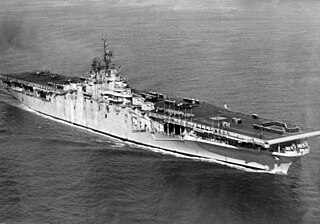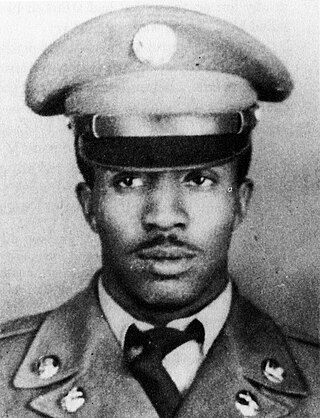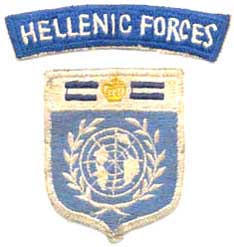This article needs additional citations for verification .(September 2009) |
Many documentary films have been made about the Korean War.
This article needs additional citations for verification .(September 2009) |
Many documentary films have been made about the Korean War.

The Korean War was an armed conflict on the Korean Peninsula fought between North Korea and South Korea and their allies. North Korea was supported by the People's Republic of China and the Soviet Union, while South Korea was supported by the United Nations Command (UNC) led by the United States. Fighting ended in 1953 with an armistice, with no treaty signed.

USS Boxer was one of 24 Essex-class aircraft carriers of the United States Navy, and the fifth ship to be named for HMS Boxer. She was launched on 14 December 1944 and christened by the daughter of a US Senator from Louisiana.
The Korea Times (Korean: 코리아타임스) is a daily English-language newspaper in South Korea. It is a sister paper of the Hankook Ilbo, a major Korean-language daily.

Missing in action (MIA) is a casualty classification assigned to combatants, military chaplains, combat medics, and prisoners of war who are reported missing during wartime or ceasefire. They may have been killed, wounded, captured, executed, or deserted. If deceased, neither their remains nor grave have been positively identified. Becoming MIA has been an occupational risk for as long as there has been warfare.

MS Jutlandia was contracted by and built for the East Asiatic Company (EAC) in 1934, as a combined passenger and cargo ship at EAC's Nakskov Shipyard, Denmark. Following an extended operational life in which she also served as a hospital ship and a royal yacht, she was finally decommissioned in 1965.

USS Chemung (AO-30), a Cimarron-class fleet replenishment oiler serving in the United States Navy, was the second ship named for the Chemung River in New York State.

No. 77 Squadron is a Royal Australian Air Force (RAAF) squadron headquartered at RAAF Base Williamtown, New South Wales. It is controlled by No. 81 Wing, part of Air Combat Group, and equipped with Lockheed Martin F-35 Lightning II multi-role stealth fighters.

Michael Kelly Finnigan was an American keyboard player and vocalist, his speciality being the B3 Hammond organ. Working primarily as a freelance studio musician and touring player, he played with a wide variety of musicians in pop, rock, blues and jazz.
The French Battalion of the United Nations Organisation was a battalion of volunteers made up of active and reserve French military personnel sent to the Korean Peninsula as part of the UN force fighting in the Korean War.

William Henry Thompson was a United States Army soldier and a posthumous recipient of the United States military's highest decoration, the Medal of Honor, for his actions in the Korean War.

The Greek Expeditionary Force (GEF) in Korea was formed in response to the United Nations appeal for assistance in the Korean War. It comprised a reinforced Hellenic Army (HA) infantry battalion and the Royal Hellenic Air Force (RHAF) 13th flight of seven transport planes (C-47). Greece originally intended to send a brigade to Korea; upon consultation with the US, however, the expeditionary force was downgraded to a battalion attached to the US 1st Cavalry Division. The 13th Flight supported the US marine division and played an important role of evacuating the dead and the wounded. After the armistice, the RHAF unit withdrew in May 1955 and the HA unit in December 1955. Greece was the fifth largest troop contributor to U.N. Forces in Korea.

Australia entered the Korean War on 28 September, 1950; following the invasion of South Korea by North Korea. The war's origins began after Japan's defeat in World War II, which heralded the end to 35 years of Japanese occupation of the Korean Peninsula. The surrender of Japan to the Allied forces on 2 September 1945 led to the division of Korea into two countries, which were officially called the Democratic People's Republic of Korea (DPRK) and the Republic of Korea (ROK). The DPRK was occupied by the Soviet Union, and the ROK, below the 38th Parallel, was occupied by the United States (US).

Yiorgos Theotokas, formally Georgios Theotokas, was a Greek novelist.
The Canadian Forces were involved in the 1950–1953 Korean War and its aftermath. More than 30,000 Canadians participated on the side of the United Nations, and Canada sent eight destroyers. Canadian aircraft provided transport, supply and logistics. 516 Canadians died, 312 of which were from combat. After the war, Canadian troops remained for three years as military observers.

The United Nations Memorial Cemetery in Korea, located at Tanggok in the Nam District, City of Busan, Republic of Korea, is a burial ground for United Nations Command (UNC) casualties of the Korean War. It contains 2,300 graves and is the only United Nations cemetery in the world. Laid out over 14 hectares, the graves are set out in 22 sites designated by the nationalities of the buried servicemembers.